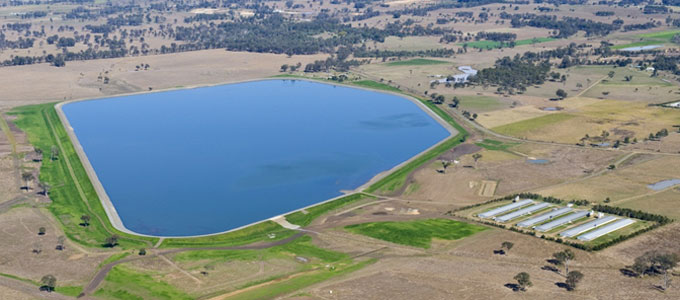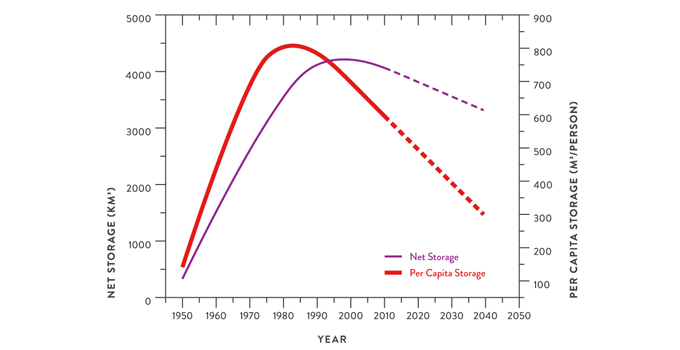THOUGHT LEADERSHIP
More water storage needed for a sustainable future
Global declines in water storage are increasingly troubling. With greater hydrological variability due to climate change, more storage will be vital to provide the same level of security of water, food and energy.

Water storage is a fundamental protection from the impacts of a changing climate, safeguarding the supply of water, and the water–food–energy nexus, even during extended drought.
For thousands of years, dams have stored water to irrigate crops, control flooding, supply water for industrial and household use, and generate hydroelectric power – contributing enormously to food security, human development and economic growth.
These days, many dams serve more than one function, but remain the primary mechanism for coping with the variability of water supply and demand. During the last century, more than 45 000 dams higher than 15 m have been constructed worldwide, creating a combined storage capacity estimated to be between 6700 and 8000 km3, representing 17 per cent of global annual runoff.
Security of water, food and energy are inextricably linked. For example, approximately 50 per cent of all large dams worldwide are used for irrigation. Without sufficient water storage, irrigated agriculture (the largest user of water at the global level, contributing 40 per cent of the world’s food) is at the mercy of changing patterns of rainfall and runoff.

Understanding water storage issues is essential for successfully managing water resources. At the simplest level, it is a matter of ‘inflow (water supply) less outflow (water demand) equals change in storage’. But it is particularly important to understand whether storage declines relate to reducing supply, increasing demand, or both. The answer is both, and more.
Key factors influencing storage are greater variability of inflows due to climate change, increased demand due to population growth, reduced net storage due to sedimentation, and less dam construction occurring worldwide due to environmental and social impacts.
Climate change
The effects of climate change are predicted to increase and to result in greater magnitude and frequency of hydrological extremes, such as prolonged droughts and significant floods. With prolonged drought, inflows to storages will reduce. If demand remains the same, stress on existing water storages will increase.
Population growth
It is estimated that in 2017 Earth supports around 7.5 billion people, yet 200 years ago the number was less than 1 billion. Population and water demand are strongly linked. With our world population increasing at around 80 million people per year, rising demands for basic services and growing desires for higher living standards will intensify the demand for water and put additional strain on existing storages.
Sedimentation
Many of the larger reservoirs worldwide have had their lifespans reduced significantly due to deposits of sediment within the storages, diminishing net storage in many regions of the world. Globally, the annual rates of loss relative to installed storage capacity are generally estimated to range between 0.5 and 1.0 per cent, equating to a total worldwide loss of storage of around 40 to 80 km3 per year.
Reduced dam construction
Installation of large reservoirs peaked during the 1960s and 1970s, both in number and storage volume. However, some of these larger reservoirs caused significant environmental and social damage, bringing dam construction under great scrutiny and ultimately decreasing dam construction worldwide.
With less dam construction, some decommissioning of older dams and loss of storage due to sedimentation, net storage worldwide is falling, most dramatically in storage per capita. Such reduction in storage is likely to undermine reliability of supply.

Source: GW Annandale, GI Morris & P. Karki, Sediment Management at Reservoirs and Hydropower Plants: New World Bank Technical Note, ICOLD International Symposium, Johannesburg, May 2016.
Few kinds of development projects arouse as much controversy as dams. However, large dams vary considerably in their environmental and social impacts. The severity of environmental impact is largely determined by the dam site. While dams at good sites can be very defensible from an environmental standpoint, those proposed at bad sites will be inherently problematic even if all feasible mitigation measures are properly implemented. The challenge is to find the good dam sites to enable these necessary water storages to be developed.
How can we take action?
The following actions form a useful response to reduced worldwide storage and the pressing need to increase water storage to maintain reliable water supply, irrigation and energy systems in a changing climate:
- Prioritise managing existing storages well, and recognise the importance of storages for maintaining reliable supply. Appropriately manage sedimentation and its impact. Employ near-real-time management of water based on improved information systems to ensure the best economic use of existing reservoirs.
- Explore opportunities to increase the storage capacity of existing reservoirs by raising dams or by improving interconnection. Often, this can be more cost-effective and have lower environmental impacts than a new dam project.
- Identify dam sites, either on-stream or off-stream, which will minimise environmental and social impacts. Good site selection is the most effective environmental mitigation measure.
The net decline in global reservoir storage demands a different mindset for analysing the economics and construction of sustainable dam projects. Rather than debating whether more dams are required, decision-makers must accept that more storage will be needed and should plan accordingly.
If you would like to find out more about how Entura can help you develop a sustainable water storage solution or respond to these worldwide challenges, contact Richard Herweynen on +61 3 6245 4130 or Shekhar Prince on +61 412 402 110.
A version of this article has been previously published in the International Hydropower Association blog.
About the author
Richard Herweynen is Entura’s Technical Director, Water. Richard has three decades of experience in dam and hydropower engineering, and has worked throughout the Indo-Pacific region on both dam and hydropower projects, covering all aspects including investigations, feasibility studies, detailed design, construction liaison, operation and maintenance and risk assessment for both new and existing projects. Richard has been part of a number of recent expert review panels for major water projects. He participated in the ANCOLD working group for concrete gravity dams and is the Chairman of the ICOLD technical committee on engineering activities in the planning process for water resources projects. Richard has won many engineering excellence and innovation awards (including Engineers Australia’s Professional Engineer of the Year 2012 – Tasmanian Division), and has published more than 30 technical papers on dam engineering.
MORE THOUGHT LEADERSHIP ARTICLES
May 31, 2017






